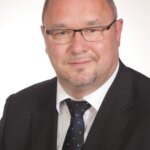SEMI Europe’s Industry strategy Symposium (ISS 2023) took place as an in-person-only event on February 15-16, 2023, at Hilton Vienna Park Hotel, Vienna, Austria. For me, this was the best ISS Europe ever. That’s not only because it is the first ISS Europe that I attended, but also because this is echoing the consistent feedback of the other attendees.
What is SEMI ISS Europe?
From the SEMI Europe website, we can read: “SEMI ISS Europe gathers executives and high-level experts to provide microelectronics market projections and insights into the latest economic and societal trends, geopolitics, and technologies shaped by the microelectronics industry. Access valuable strategic content and network with other executives to help identify new business opportunities and grow your business.”.
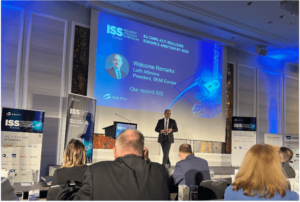
Laith Altimime, President of SEMI Europe, highlighted in his Welcome Remarks, that ISS Europe 2023 is a record ISS Europe with 220+ registered attendees, and record also in terms of diversity: 22% women attendees, and 37% women presenters. Both percentages are much higher than in the previous years. We had the highest number of industry executives participating, as well as participants and speakers from policymakers in governments and the European Commission. Laith highlighted that bringing the supply chain together is a key SEMI initiative.
He showed that the electronics industry ERA3: “Mobility” is further driving the market, but the growing ERA4: “AI, 5G, IoT” gives a strong push in the meantime too. And what comes next? ERA5: “6G+, Quantum Computing, and Neuromorphic Computing”: something we might not have in our hands for the next 5-10 years, but R&D is in full swing already. The semiconductor market size is forecasted to double between 2021 and 2030 by +$500B to a total of $1T. This was highlighted by most of the presenters, but some were more conservative.
Addressing the question of “How to make the EU CHIPS ACT a success?”, Laith stated that so far, we have concentrated on design, equipment, manufacturing – also packaging got listed here – and RTOs. But now materials, chemicals, and gases are also becoming key elements that are instrumental for a sustainable supply chain. Sustainability, smart and green manufacturing solutions, paving the way to Net Zero, equality, diversity, and inclusion, and closing the talent gap were highlighted as success factors.
The symposium was themed “EU CHIPS ACT: Realizing Europe’s Ambition by 2030”. While the theme got naturally formulated optimistically, some presenters gave less optimistic statements. I felt most of the attendees agreed, while others might have been thinking it was better than nothing.
“The EU CHIPS ACT is the last call, but the amount of money is ridiculous. It’s too small, too slow, and too inefficient. Europe’s position has constantly deteriorated in the past, and Europe let it happen.”
(Michael Alexander, Partner, Advanced Technology Center, Roland Berger, Germany, during his presentation).
“Europe needs to get more paranoid about Semiconductors. The US and Asia are.”
(Jo De Boeck, Executive Vice President & Chief Strategy Officer at imec, Belgium, during the panel discussion)
When the SEMI ISS Europe committee chair, Leonard Hobbs, General Manager of MIDAS Ireland, opened the first session “Industry Strategy and Market Forecast”, he clearly underlined that future challenges in our industry can be encountered in close collaboration of the complete semiconductor supply chain only. He invited all attendees to use the event to heavily network, and he gave us the task to make at least three new contacts during the two days while networking with the existing contacts too, of course. With a wink, Leonard promised to check that and to get after those who did not make three new contacts yet. Isn’t that a great icebreaker?
Michael Wiesmüller, also called “Mr. Semiconductors Austria”, won the longest affiliation award. He is the Head of the department, Key Enabling Technologies for Industrial Innovations: ICT, Manufacturing & Nanotechnologies, Republic of Austria, Federal Ministry for Climate Action, Environment, Energy, Mobility, Innovation & Technology. This title is on purpose, as it shows the complex context of our industry. Having in mind the diversity our industry needs, he mentioned in his welcome note that the majority of experts he sees in the room are “of my gender and age”, which I translated into 50+ years. Michel broached the issue of us being in a poly-crisis that shapes politics too. It needs short-term emergency actions, while not forgetting to follow a long-term strategy.
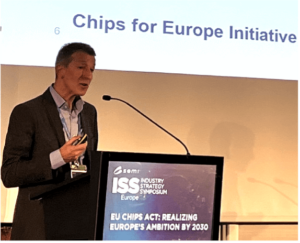
Francisco J. Ibáñez, Senior Policy Officer, Microelectronics & Photonics Industry, DG Connect, European Commission, said that moving from 8% to 20% semiconductor market share by 2030 is a large target. Previous plans to reach that target failed. Indeed, 20% is very ambitious. But besides the numbers, what we need to achieve by 2030 is the status of a strong presence in semiconductors, being an accepted and needed partner for other regions. We need to strengthen our negotiation position.
Bridging the “Gap from Lab to Fab” is a major task here in Europe. We need to do something in skills, preparing our future generations of the workforce in the industry. Even and especially in times of “de-globalization”, we need international cooperation and good diplomacy. Compared to other regions in the world, Europe is doing very well in reducing greenhouse gas (GHG) emissions. Is the price for that contributing to a competitive disadvantage? Later in the panel discussion, the European Paradox was mentioned. This has been discussed for the past 20 years: Being the best in the world for R&D — Semiconductors worldwide would not be where it is today without European players like imec and ASML — but not materializing this in production.
After the new very optimistic semiconductor market size forecast (doubling between 2021 and 2030 by +$500B to a total of $1T) was shown by almost all presenters before, YOLE Intelligence CTO, Guillaume Girardin, offered a more sober view. He apologized for being less enthusiastic than other speakers. Between 1990 (~$71B market) and 2022 ( ~$594B market) we saw 8x growth. His prediction for 2030 is not $1T but $800B, which he says is still very much OK. As another fact, Guillaume reduced the average age of the Day-1-Speakers by 5-10 years, illustrating there is still hope. Lack of talented resources is seen in all regions of the world today, he said. While Europe is lucky compared to the rest of the world, it is also struggling.
Next, analyst Malcolm Penn, Founder & CEO of Future Horizons, took the stage, making the audience wonder. Pointing to the ISS Europe committee, he complained that he was not invited as a distinguished speaker getting 20 minutes time to speak, but 10 minutes only. However, he filled those 10 minutes with a clear message: Facts and figures of the last 30+ years showed clearly that the market cyclicality for semiconductors IS normal. That’s a hard lesson of history, he said. This is a market of boom and slump. Demand goes up and down faster than the industry can react. There is either over- or undersupply, nothing in between, and that makes the cycles. Having the right capacity at the right time is not possible. After massive growth in 2022, the 2023 downturn – a normal part of the cycle – will be around -22%. Maybe less, but a low single-digit number is “impossible”. This looks like a horrible number, but it does not change the fact that it is a real number, he said. It is too early to call the outlook for 2024, but he recommended that we invest in R&D to have products for the future, double down on R&D, and start planning for the next upturn NOW (First Mover Advantage). His methodology allows predicting up- and downturns 12-18 months before. Decision makers might want to purchase Malcolm’s reports in the future to be prepared.
At the end of the first symposium day, the 2022 European SEMI Awards were presented:
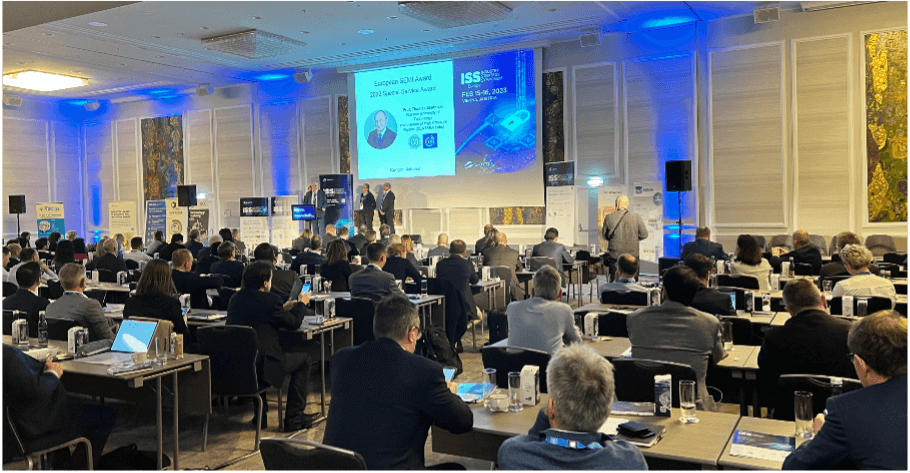
- Prof. Thomas Skotnicki of Warsaw University of Technology and the Institute of High-Pressure Physics (CENTERA Labs) was honored with the 2022 Special Service Award.
- Francoise Chombar, chairwoman of Melexis, received the 2022 European SEMI Award.
Kicking off the second day, Michael Alexander, Partner, Advanced Technology Center, Roland Berger, Germany, stated that de-globalization has already started. We see a reduction in R&D spending, a significant decrease compared to sales. Our industry has been doing great in the COVID crisis, outperforming anyone. Market size and market capitalization of high-tech companies are growing unprecedentedly. There is a reorganization and redistribution of opportunities and risks, he said. We see a change in the degree of free trade. The semiconductor industry is moving away from globalization: In December 2021 we moved into the “War of Technology”. One year later, in December 2022 – after a ten-month war in Ukraine – we are in the middle of the “War of Technology”, Michael pointed out. Protectionism has always been evil to globalization.
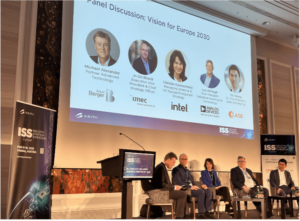
In the panel discussion, Michael noted: “In Europe, and especially in Germany, we have a tendency to overengineer things. Other regions are more pragmatic. We got a very complex EU CHIPS ACT, but we need to create conditions faster. Our industry is a fast industry. We don’t have the time to do a complex EU CHIPS ACT. This takes too much speed and energy.”.
ASE Group’s Yin Chang, Senior VP, of Sales & Marketing – the only non-European panelist in the panel – was asked about the discussions he has had with European customers on de-globalization. He does see a global localization to avoid supply chain interruption, but differentiates between standard to most advanced packaging, the need of today and of tomorrow. ASE Group just started manufacturing in Europe by acquiring a company in Poland. Yin sees potential in Eastern Europe. Europe is seeing the consolidation of Western and Eastern Europe, he stated. His comment that “It is a shame that wafers produced in Europe have to leave Europe for packaging, assembly, and test for the European OEMs.” points to the sustainability principle: “Manufacture where you sell.”.
Christin Eisenschmid, Managing Director and VP of Europe Ecosystem Strategy of Intel Germany, was asked about investment in Europe. We know about the planned 2nm wafer fab in Magdeburg, Germany, and plan to build an advanced packaging manufacturing site in Italy. Christin pointed out that Intel has been in Europe for a long time. It started 30 years ago in Ireland and Israel – globally some of the strongest performing sites. Intel has been global all the time. Intel believes in the European talents and eco-system with imec, ASML, and many other supporters and suppliers. Momentum is here but needs more collaboration.
A Pan-European setting while staying international also in times of de-globalization trends was requested by panelist Jo De Boeck, Executive Vice President & Chief Strategy Officer at imec in Leuven, Belgium. Imec is a great example, uniquely established for a long time. It offers a full stack of innovation, Jo said. We need to make sure to embrace all the technologies. A combination of More-Moore (MM) and MtM (More-than-Moore) is the solution, not one alone. Institutes like imec need an aligned and common view with the international industry moving forward to be successful.
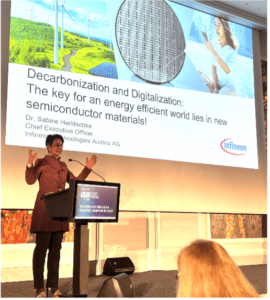
“Decarbonization and Digitalization: The Key for an Energy Efficient World Lies in New Semiconductor Materials!” was the title of the presentation of Sabine Herlitschka, CEO of Infineon Technologies Austria AG. The two biggest challenges of our and future generations go hand in hand. This is a “twin transition”: Decarbonization and digitalization. The key to the next essential step towards an energy-efficient world lies in the use of new materials. SiC reached new levels of power density and performance. Infineon sees skyrocketing demand. The new form factors are much more attractive than standard MOS, CoolMOS, and GaAs. GaN will enable a significant step forward towards energy efficiency and size weight reduction in a variety of applications.
It was the day of Infineon’s General Assembly in Munich, and the approval announcement for the €5B investment – including €1B subsidies – in the new Wafer Fab extension in Dresden, Germany, adding significant manufacturing capacities in Europe. “We in Europe have to build much more on our strength to be fit for global competition. Infineon is a market leader in Power Semiconductors (20% market share). Other regions depend on Europe here!” Sabine highlighted.
There were also presenters and panelists from Soitec, STMicroelectronics, Cadence, Air Liquide Electronics, Comet Yxlon, IMS Nanofabrication, IBM, Analog Devices, Schneider Electric, Edwards, Merck, VTT Technical Research Centre, Imec, BESI, and Clever Carbon.
There was also an interesting and motivating panel discussion on the burning topic “Closing the Talent Gap and Cultivating the Workforce of Tomorrow”, moderated by Cassandra Melvin, Senior Director of Business Development & Operations at SEMI Europe.
The event was enriched by many good networking opportunities. It was no problem at all to fulfill the task that SEMI ISS Europe committee chair, Leonard Hobbs, gave to all attendees during his session 1 opening talk to make at least three new contacts during the two days.
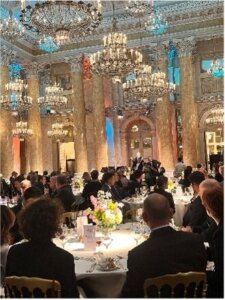
On the evening of the second symposium day, attendees were invited to a glamorous networking reception and gala dinner with live classical music played in the ballroom of Hofburg Vienna. For those curious, this had nothing to do with the famous Vienna Opera Ball 2023, which took place the same day at the Vienna State Opera House. After his welcome and symposium summary address, Laith Altimime invited Dirk Hilbert, Lord Mayor of the city of Dresden, and Thomas Richter, SVP & MD of Infineon Technologies Dresden, onstage to congratulate and give them both the chance for a short speech, celebrating the announcement of the day, that the €5B investment in the Smart Power Wafer Fab in Dresden has been released and construction work can start. Completion is planned for 2026. The Fab will generate 1,000 new jobs.
3D InCites was a Media Partner of SEMI ISS Europe 2023 and represented the 3D InCites community members. There was a promotion stand and rollups inside and outside the meeting room. The next SEMI ISS Europe 2024 will take place March 7-8, 2024, again at the Hilton Vienna Park Hotel, Vienna, Austria. Please mark your calendars.
For the full event report with more information and details, the author offers this in his new ECENT-Series of “ESPAT-Consulting Event Notes and Thoughts”. Please contact: steffen.kroehnert@espat-consulting.com for details.









